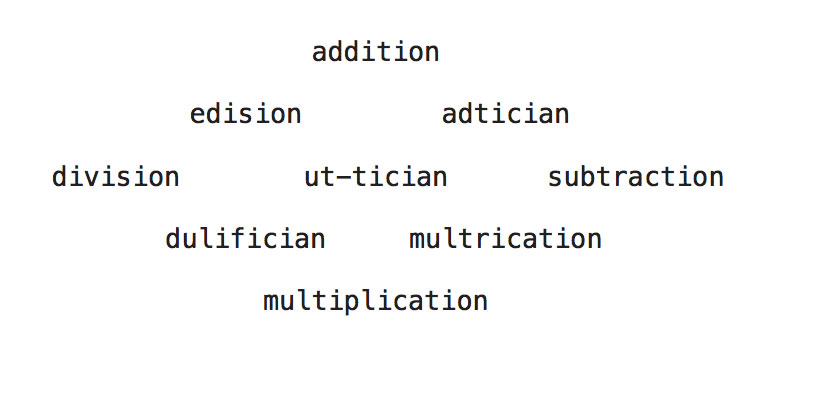Allison Parrish, Everyword (Instar Books, 2015).
Parrish, Everyword, xv.
See →.
See →.
See →, among many others.
Many of these are also based on Parrish’s original dataset for @everyword itself, which she released in 2014 (Parrish, Everyword, xxi–xxii).
See →.
See →.
There are other kinds, like the “ebooks” genre that generates posts from a user’s extant corpus, which don’t work in quite the same way. This is outside the scope of this essay, but for more on bot art in general, see Everst Pipkin’s essays “Language After the Writing Machine,” Medium, October 25, 2015 →, and “Selfhood, The Icon, and Byzantine Presence on the Internet,” Medium, March 12, 2016 →.
See, for example, the bot that reads through (some) of Moby-Dick, which seems to have extracted the maximum amount of pithiness from the book →.
Parrish, Everyword, ix.
Parrish, Everyword, xiv.
Parrish, Everyword, xiv.
Parrish, Everyword, xiv.
Kathy Acker, “Seeing Gender,” Critical Quarterly 37, no. 4 (1995).
Acker, “Seeing Gender,” 84.
Allison Parrish, “Lossy Text Compression, For Some Reason?!” (talk given at !!Con, 2016 →).
Allison Parrish, “Toward a Material Poetics of Textual Waveforms” (talk given at Alt-AI, 2016 →).
Allison Parrish, “Frankenstein-Genesis,” Vetch, no. 3 (Autumn 2016).
See Tomas Miklov et al., “Efficient Estimation of Word Representations in Vector Space,” 2013 →.
The canonical example is Susan Stryker’s 1994 essay “My Words to Victor Frankenstein Above the Village of Chamounix: Performing Transgender Rage,” GLQ 1, no. 3 (1994).
One might also be reminded of Shelley Jackson’s 1995 hypertext novel Patchwork Girl, another (and much more complex) electronic rewriting of Frankenstein, one that shares with Stryker a similar investment in the monster (and the monstrous text) as a created thing, even if Jackson goes about it in a completely different way.
Allison Parrish, The Average Novel →.
Parrish, The Average Novel.
See Kim Cascone’s “The Aesthetics of Failure: ‘Post-Digital’ Tendencies in Contemporary Music,” Computer Music Journal 24, no. 4 (2000): 12–18.
My understanding of noise as an aesthetic language is indebted to Leah Eff’s essay “A Sex Close To Noise” →.
See, for example, Trisha Low’s “On Being-Hated: Banks Violette, Pharmakon, Karaoke”: “She demands the audience face what they’ve created: this unquestionably feminine body they’ve betrayed, a body that has become traitorous for giving itself over to rage.” Open Space, March 9, 2015 →.
See →.
“Exploring Semantic Space With (Literal) Robots” (lecture given at Eyeo, 2015 →).
Also of note is that Parrish often quotes Amiri Baraka’s 1970 essay “Technology & Ethos” in her lectures, an Afrofuturist work that calls for the reworking of technology on a fundamental level in the service of black liberation. I see something of an analogy between Parrish’s machinic search for new language and Baraka’s call for “engineers, architects, chemists” to put their efforts toward not only liberation but the reconceptualization of how knowledge is produced altogether.
Allison Parrish, The Ephemerides →.
Or at least until API changes stopped the bot’s functioning in 2017.
See Parrish’s note on The Ephemerides from her web portfolio →.
Allison Parrish, Compasses (Sync, 2019) →.
There’s much more of an expectation about what a novel will generally do than, say, a poem, and Parrish’s “novel” does almost none of these things. This piece (as well as The Average Novel) was generated for Darius Kazemi’s “NaNoGenMo,” a riff on “national novel writing month” in which programmers write a program that generates fifty thousand words of text, without stipulations on readability or coherence. I choose to call Our Arrival a novel because Parrish does.
Allison Parrish, Our Arrival, iii →.
Parrish has created a database of every plaintext file on Project Gutenberg, which she used in this project. The selection was done by an NLP algorithm called spaCy. See →.
Parrish, Our Arrival, 1, 3.
“Special Features: Allison Parrish,” Ninth Letter →.
Allison Parrish, Articulations (Counterpath Press, 2018), v–vi.
Allison Parrish, “Poetic Sound Similarity Vectors Using Phonetic Features,” 2017 →.
Parrish, Articulations, 24, 45–56, 57.
